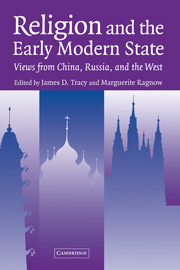Book contents
- Frontmatter
- Contents
- Contributors
- Acknowledgments
- Preface
- Religion and the Early Modern State
- Introduction
- PART I LIVED RELIGION AND OFFICIAL RELIGION
- 1 The Alternative Moral Universe of Religious Dissenters in Ming-Qing China
- 2 Ecclesiastical Elites and Popular Belief and Practice in Seventeenth-Century Russia
- 3 The State, the Churches, Sociability, and Folk Belief in the Seventeenth-Century Dutch Republic
- 4 Communal Ritual, Concealed Belief: Layers of Response to the Regulation of Ritual in Reformation England
- PART II FORMS OF RELIGIOUS IDENTITY
- PART III THE SOCIAL ARTICULATION OF BELIEF
- AN EPILOGUE AT THE PARISH LEVEL
- Selected Annotated Bibliography of Secondary Works
- Index
4 - Communal Ritual, Concealed Belief: Layers of Response to the Regulation of Ritual in Reformation England
Published online by Cambridge University Press: 23 May 2010
- Frontmatter
- Contents
- Contributors
- Acknowledgments
- Preface
- Religion and the Early Modern State
- Introduction
- PART I LIVED RELIGION AND OFFICIAL RELIGION
- 1 The Alternative Moral Universe of Religious Dissenters in Ming-Qing China
- 2 Ecclesiastical Elites and Popular Belief and Practice in Seventeenth-Century Russia
- 3 The State, the Churches, Sociability, and Folk Belief in the Seventeenth-Century Dutch Republic
- 4 Communal Ritual, Concealed Belief: Layers of Response to the Regulation of Ritual in Reformation England
- PART II FORMS OF RELIGIOUS IDENTITY
- PART III THE SOCIAL ARTICULATION OF BELIEF
- AN EPILOGUE AT THE PARISH LEVEL
- Selected Annotated Bibliography of Secondary Works
- Index
Summary
In 1551, John Hooper, fresh from his battle with Archbishop Cranmer over vestments and his consecration as bishop of Gloucester, prepared for the initial visitation of his new diocese. Twenty-five years later, in one of a number of nearly concurrent moves to define English Protestantism more fully, Archbishop Edmund Grindal prepared for a similar visitation of that same diocese as part of a general visitation of the province of Canterbury. In each case, the emphasis was on the reformation of ritual, and the concerns expressed were prompted by the condition of worship across the realm.
A year before his elevation to the bishopric, John Hooper had written to his friend and mentor, Heinrich Bullinger in Zurich, expressing his frustration with the pace of religious reform in England. “Partly through ignorance, and partly fascinated by the inveiglements of the bishops, and the malice and impiety of the mass-priests,” the people were not turning to the new religion nearly fast enough. Now Hooper was in a position to hasten the pace of reform and to promote and enforce policies associated with English Protestantism in at least one corner of the kingdom. As bishop, he would carry out his duties with impressive vigor and attention to detail. He clearly believed, as did most of the other English reformers, that the reformation of ritual was a key to establishing “true religion” among the clergy and people of England and thereby creating a kingdom with which God would be pleased.
- Type
- Chapter
- Information
- Religion and the Early Modern StateViews from China, Russia, and the West, pp. 98 - 118Publisher: Cambridge University PressPrint publication year: 2004

